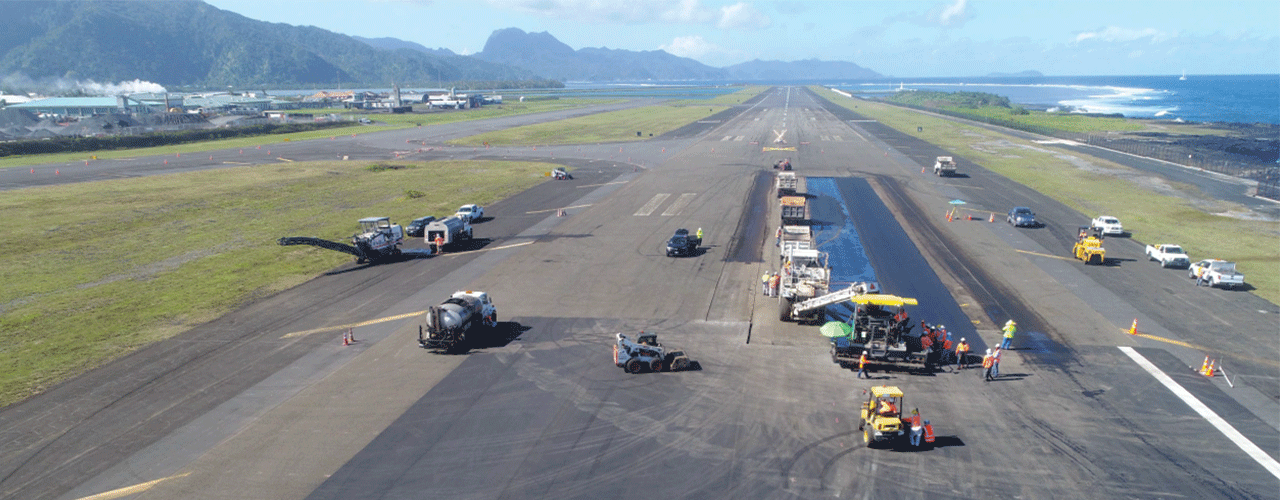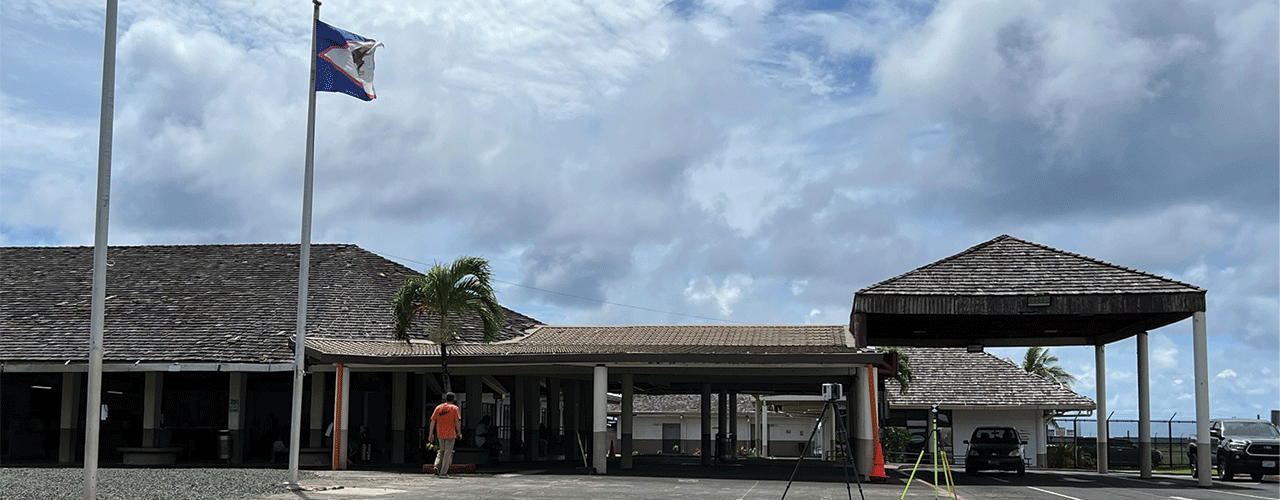Airports Airfield Pavement Maintenance Program

Background
At Pago Pago International Airport (PPG), the terminal apron was experiencing age related distresses and heaving of the pavements due to larger aircraft (A330) utilizing the airport. Additionally, the existing fueling and electric power infrastructure was at capacity and had reached the end of its design life. In addition to the terminal apron rehabilitation, the Primary Runway (5/23) was experiencing age and environmental distresses, so it needed rehabilitation to remain serviceable and safe for the airlines.
The runway at OFU Airport (Z08), a small but vitally important airport, was showing significate age related distresses, including broken concrete panels, heaving, settlement, ponding water, and extensive surface weathering. The runway was not compliant with current Federal Aviation Administration (FAA) standards due to issues such as obstructions and roadways within the safety area as well as runway widths that were too narrow.
At Fitiuta Airport (FAQ), the runway pavements were in compliant and satisfactory condition, but the runway lights and backup generator were damaged and no longer functioning. The airlines desired to resume night and evening airline operations; therefore, the lights needed to be restored to working condition.
Woolpert was selected for these projects because of our knowledgeable staff and extensive experience. Our staff, while working on another project, engaged in conversations with the management of the airports and identified ways we could help address critical issues and offer the full expertise of Woolpert. This conversation resulted in Geospatial, Engineering, Electrical, and Planning disciplines all assisting the client to address their needs at all three managed airports. The Woolpert team is proud to serve and support the American Samoan Government with their airfield projects.
Challenge
Logistics planning, coordination of funding and phasing of the work, and construction support from a distance were at the forefront of every design solution. Several of the projects were also constructed during the COVID-19 pandemic, so Woolpert had to develop flexible and cost-effective solutions amidst shipping, labor, and material shortages to ensure the success of the work.
For both the terminal apron and Runway 5/23 rehabilitation projects at PPG, it was imperative that the airport maintain passenger and cargo operations without interruption. Therefore, Woolpert sequenced the work so that it would occur in the few days between scheduled flights while restoring the airport to a fully compliant condition at the end of each work period.
Because of the remote and culturally significant location of OFU, it was critical that alternative transportation be available during the runway reconstruction, which was provided via chartered sea ferry. In addition, Woolpert needed to coordinate material deliveries with production.
Solution
In each project, Woolpert partnered with the American Samoan Government to identify concerns and potential impacts, working together to develop the right solutions for the circumstances. At PPG, the Woolpert team designed a fuel piping system that could be installed in phases to maintain constant fueling for commercial service aircraft. Woolpert designed the rehabilitation of the only internationally flight capable runway so that it could be restored to a fully compliant state every three days, thereby ensuring that commercial service would continue without interruption. This approach was not only unique but also extremely cost effective.
For the OFU project, Woolpert reconstructed the runway, translated it to the south, extended it by 200 feet, and adjusted the geometry to allow for a second extension in the future. The Woolpert engineering team’s forethought and careful planning not only solved the current problems for the Government but also allowed the opportunity for growth and development in the future.
Finally, at FAQ, the Woolpert team designed an airfield lighting and backup generator system that would serve the airport and airlines for years, regardless of the weather.
Even though pavement and airfield lighting rehabilitation are traditional engineering projects, these solutions demonstrate that considerations of operations, environmental conditions, and construction techniques make the difference between good engineering and the exceptional engineering that Woolpert is known for.
Outcome
Woolpert provided engineering design, planning, and construction management for all of these projects. At the conclusion of the work, Woolpert was selected for additional pavement rehabilitation and construction services, which is a testament to both the quality of Woolpert’s work and the client’s satisfaction.

Benefits
- The infrastructure of each airport has been updated to support safe and efficient operations and comply with current FAA standards.
- The projects were completed in a cost-effective manner without halting airport operations.
- Woolpert’s solutions provide for additional improvement projects in the future.
Client
American Samoa Government-Department of Ports Administration
Location
American Samoa